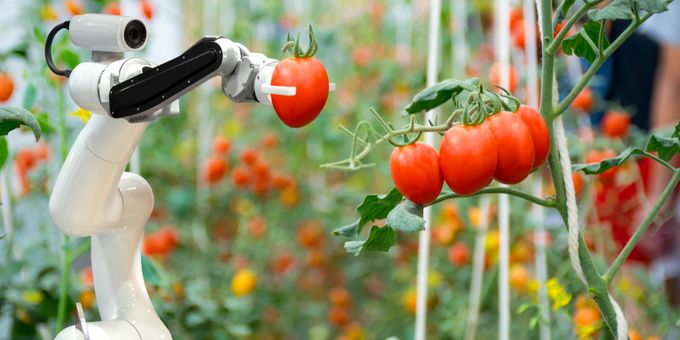What’s more, from shepherding to nursery planting, robots have already made their way into the agriculture industry. The death of skilled labor is another factor that propels the demand for agricultural robots.
 Readers Choice 2020: Age Of Agriculture Robots: Fruit-Picking Robots And Drones To Take Over Farms
Readers Choice 2020: Age Of Agriculture Robots: Fruit-Picking Robots And Drones To Take Over Farms

Swamini Kulkarni | Allied Market Research
The little blue planet of ours is crowded with over 7.8 billion humans and soon we have to increase our agriculture production drastically to meet with the ever-rising demand. To achieve this–just like any other industry–the agriculture industry must incorporate robotics to speed up processes such as manufacturing, transportation, customer service, packaging, and shipping.
According to Allied Market Research, a research firm, the global agriculture robots industry is expected to reach $11.05 billion by 2023, growing at a CAGR of 21% from 2017 to 2023. The growing demand for food production and the rise in demand for indoor farming are the major drivers for the growth of the market.
What’s more, from shepherding to nursery planting, robots have already made their way into the agriculture industry. The dearth of skilled labor is another factor that propels the demand for agricultural robots. According to a study, most of the hired farm workers are immigrants and the majority of them lack proper documentation. Keeping the global political situation in mind, the flow of workers is bound to decrease, which further boosted the need for agricultural robots.
Demand for fruit-picking robots
The long-lasting perception of agriculture robots is that they are bulky and clumsy. However, the traditional robots are evolved and are delicate enough to pluck berries off its stem.
Recently, Frontier IP, an intellectual property commercialization company, announced that the company has acquired around £0.3 million funding. The company clarified that the funding would be used to accelerate the development of soft fruit harvesting robots.
Prior to this, Frontier IP had launched a raspberry-picking robot, which now has successfully completed two field trials. The company describes while developing the robot they had to overcome several challenges. Raspberries are delicate and softer than any other fruits and they grow on bushes with complex foliage and berry distribution. Thus, after launching a fruit-picking robot, the company wants to focus on developing proof-of-concept robots for other crops as well.
French startup bags €14 million to expand eco-farming robots
Naïo Technologies, the Escalquens-based startup that focuses on agricultural robots, recently announced that it bagged €14 million funding from Bpifrance.
Founded in 2011, Naïo Technologies was founded by robotic engineers Gaëtan Séverac and Aymeric Barthes and they have been working closely with farmers. The company developed weeding robots that are eco- as well as user-friendly. The robot offers assistance to a farmer in daily work, help limit the use of chemicals and aid in reducing exhausting physical workload.
Till now, Naïo has deployed nearly 150 robots at vineyards and farms in the U.S. and Europe. The company’s success is credited to the contribution toward sustainable agricultural practices and its ability to fulfill customers’ demands. For this, the company has developed a standard navigation system that can be implemented on any kind of off-road agricultural robot.
As per the company, the new investment would enable it to maintain its foothold the market and acquire technology maturity for the purpose of mass production.
Drones for crop monitoring and data collection
Farmers with large farms need 24x7 monitoring and collection of data. While there are several robots to perform this task, drones are the most effective technology.
The leading company, Agribotix that offers low-cost drones for the collection of crop data for a longer time and in real-time. The drone can take aerial photographs, measure crop health, and record videos of them using infrared sensors. With the help of drones, farmers can improve crop management and reduce the spread of crop diseases.
Apart from this, drone technology is widely used in precision farming. It refers to how farmers monitor crops to ensure the efficiency of various inputs such as fertilizers and water and improve the quality and productivity of the yield. Precision farming also deals with minimizing pests, diseases, and unwanted flooding.
To achieve this, drones are highly effective. It can continuously monitor livestock and crop. Moreover, it can rapidly and frequently perform ground-level spot checks. For instance, drones can spot if a part of the field is not being properly irrigated.
According to a study, the drop in agricultural production is directly proportional to the lack of bees across the globe. Given that bees are essential for pollination, scientists have developed artificial bees in the form of drones.
The use of robots in agriculture has taken its momentum. The tedious and repetitive tasks including harvesting and selective spraying can be performed by robots. Moreover, the lack of labor is a major challenge for farmers. The unstable political situations across the globe have hampered the import of labor from other countries. Thus, such factors and lack of pollinators and continuous monitoring for precision farming has made the agricultural robots the need of the hour.

Swamini Kulkarni holds a bachelor’s degree in Instrumentation and control engineering from Pune University, and works as a content writer. She is deeply fascinated by the impact of technology on human life and loves to talk about science and mythology. When she is not glued to the computer, she loves to read, travel, and spend time thinking how she could read and travel more often.
If you like this article you may like "The Age of Autonomy: Robotic Solutions for the Horticulture Industry"
The content & opinions in this article are the author’s and do not necessarily represent the views of AgriTechTomorrow
Comments (0)
This post does not have any comments. Be the first to leave a comment below.
Featured Product


